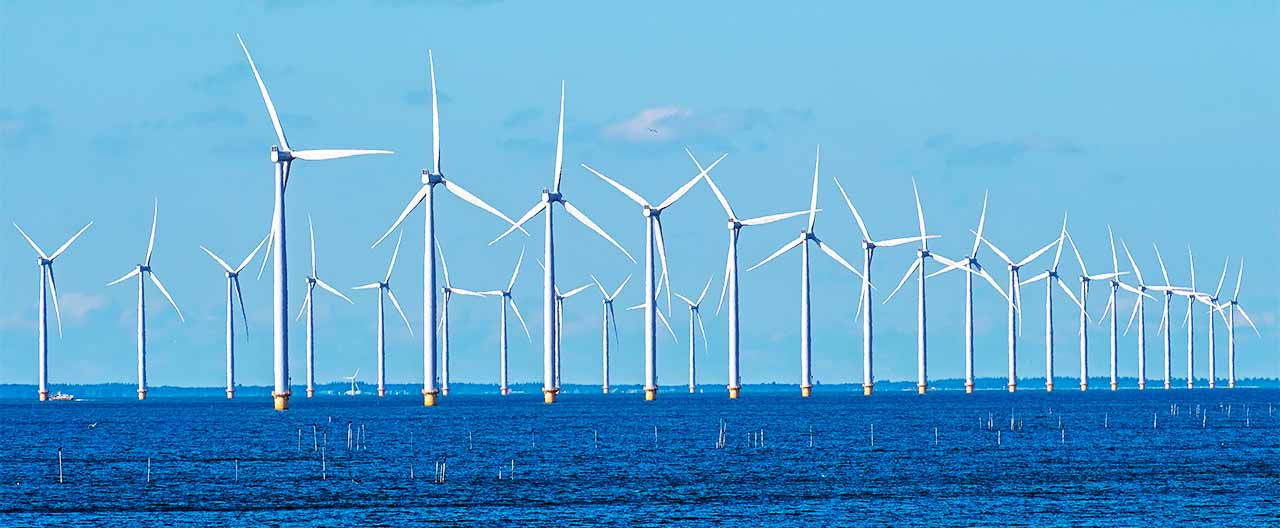The transition to a net-zero economy calls for decarbonisation across all sectors. In the power sector, this means moving away from the production and burning of fossil fuels – a major contributor to carbon emissions – and moving towards clean energy alternatives like solar and wind.
Over the past two decades, as costs have fallen and technology has evolved, renewable energy capacity has skyrocketed worldwide. According to the World Resources Institute, the cost of solar electricity has fallen by 85 percent since 2010, and the cost of both onshore and offshore wind electricity has fallen by 50 percent. Among renewable energy sources, offshore wind energy has increased at an especially astonishing rate. In 2010, global offshore wind capacity was being measured at 3.1. gigawatts (GW). By 2020, it had grown to 34.4 GW, representing more than a tenfold increase. And by 2023, just three years later, operational offshore wind capacity had nearly doubled to 68 GW – enough to power more than 47 million homes for an entire year.
One way to maximise the many benefits of wind energy is meshed offshore grids. One might think of these as smaller, seaborn versions of the land-based grid: networks of offshore windfarms linked to one another by high-voltage direct current (HVDC) cables and capable of sharing power amongst themselves. Meshed systems can provide an alternative path for energy delivery in the event of an outage or other disruptive event at any one of the interconnected facilities. By allowing for the redirection of generated power, they can help ease the grid congestion that leads to curtailment – the term for when clean-energy producers are forced to temporarily reduce their output so that grid operators can maintain the balance between energy supply and demand. Interconnectivity can also yield economic benefits for consumers by injecting more wind energy into markets where demand, and costs, tend to be higher.
Optimising offshore wind with HVDC
The typical offshore windfarm uses an array of high-voltage alternating current (HVAC) or HVDC cables to send its generated power to substations and, ultimately, the grid. This linear, point-to-point pathway is called a radial interconnection. Whilst some of these windfarms are way out at sea – the currently-under-construction Dogger Bank windfarm project, for instance, will sit more than 130 kilometers off the English coast—the majority of windfarms are found much closer to shore, and for these facilities HVAC cables are generally well suited to the job of energy transmission.
They’re less well suited, however, for transmitting power across greater distances. For every extra kilometer that an HVAC cable extends, slightly less energy gets to its final destination (a phenomenon known as “transmission loss”). As a result, most HVAC lines don’t stretch for more than about 80 kilometers. The meshed offshore grids currently being envisioned in Europe and the U.S. would potentially link windfarms separated from one another by hundreds of kilometers. Because HVDC cables have much lower rates of transmission loss, they’re far better at carrying large amounts of power over long distances with maximum efficiency. Thus are HVDC cables seen as an infrastructural requirement for any sort of meshed offshore network.
Engineers, policymakers, and energy analysts are bullish on the potential of HDVC-supported meshed offshore grids to bring more renewable wind energy into the power sector globally. But all of them acknowledge that whilst speed is of the essence, the development of these clean energy resources must be approached with a full awareness of their complexities.
Unique challenges
Those complexities include the higher cost of installing and maintaining the HVDC infrastructure that’s required to make meshed offshore grids viable – a cost that may not be feasible within emerging markets and developing economies. Though HVDC cables end up being more economical than their HVAC counterparts when stretched over long distances, the need for extra equipment, such as terminal converter stations, represents a significant upfront expenditure. Other factors that may negatively impact the decision to invest include the volatile price of copper, the principal conductive material used in subsea interconnectors; the scarcity of cable-laying vessels (there are only about 40 such ships worldwide well suited for the job); supply chain issues; and the difficulty of finding trained professionals with the specialised skills necessary for HVDC installation and maintenance.
To “modernise” the grid necessarily means to digitalise it. Although any newly created meshed offshore networks would reap the benefits that come with digitalisation (including improved demand response and increased capacity for energy storage), they would also be subject to the attendant risks, including the risk of cyberattack. And although physical attacks are uncommon, subsea cables are vulnerable to damage inflicted intentionally by malicious actors. That risk is only likely to grow as the technology surrounding deep-sea exploration advances and it becomes ever easier to deploy autonomous or remotely piloted devices onto seabeds.
Most damage, however, is inflicted naturally or accidentally. Underwater earthquakes and landslides are not uncommon, and the phenomenon known as hydrodynamic scour, where fast-flowing water carves into the seabed as it makes its way around objects, can dramatically alter undersea topography. Other risks come in the form of remotely operated vehicles (ROVs) that skitter across the ocean floor during underseas research operations, as well as fishing gear and anchors dropped from boats.
The way forward
How can we set the stage for meshed offshore grids? First, energy companies will need to find new and improved methods for manufacturing, transporting, and laying undersea cable to minimise the risk of damage, as well as new methods for identifying and locating cable faults to speed up repairs. More sophisticated systems for monitoring the activity of trawlers and other seagoing vessels, combined with the development and enforcement of “early warning” protocols, will help reduce the impact of damage to cables by anchor strike. At the policy level, governments should work with windfarm operators, the fishing industry, and other stakeholders to establish exclusion zones limiting vessel activity over and around cable siting. And we also need quicker, more streamlined permitting processes for meshed grids; permitting-related bottlenecks are already a chief source of complaint by energy companies.
According to the assurance and risk management provider DNV, 80 percent of all insurance claims filed by offshore wind companies involve subsea cable failure. The development of meshed offshore grids presents an opportunity to update and improve cable performance, and with it the performance of the entire offshore wind sector. Doing so will mitigate risk in several ways. The meshed network model significantly reduces the risk of single point of failure – a key vulnerability of the radial, point-to-point transmission model. By building resilience directly into the system through diversification of resources and assets, meshed offshore grids will also mitigate the impact of transmission-threatening damage to wind infrastructure from extreme weather events. Greater efficiency will lower operating costs over time. All of these will increase the insurable value of wind projects and create the potential for lower premiums.
Insurers have a crucial role to play in these projects as both students and managers of risk – some of which will be new and unfamiliar. Chubb's ability to meet this challenge is unsurpassed. Our diverse team of risk engineers includes clean energy specialists with a deep and comprehensive understanding of the offshore wind sector, and we offer tailored insurance products across commercial lines designed to make windfarm owners and grid operators feel more secure as they work together to get us closer to our net-zero goals. With Chubb as their partner, they can get us there faster.
All content in this material is for general information purposes only. It does not constitute personal advice or a recommendation to any individual or business of any product or service. Please refer to the policy documentation issued for full terms and conditions of coverage.
Chubb European Group SE (CEG) is an undertaking governed by the provisions of the French insurance code with registration number 450 327 374 RCS Nanterre. Registered office: La Tour Carpe Diem, 31 Place des Corolles, Esplanade Nord, 92400 Courbevoie, France. CEG has fully paid share capital of €896,176,662. UK business address: 40 Leadenhall Street, London, EC3A 2BJ. Authorised and supervised by the French Prudential Supervision and Resolution Authority (4, Place de Budapest, CS 92459, 75436 PARIS CEDEX 09) and authorised and subject to limited regulation by the Financial Conduct Authority. Details about the extent of our regulation by the Financial Conduct Authority are available from us on request.
Insights and expertise













